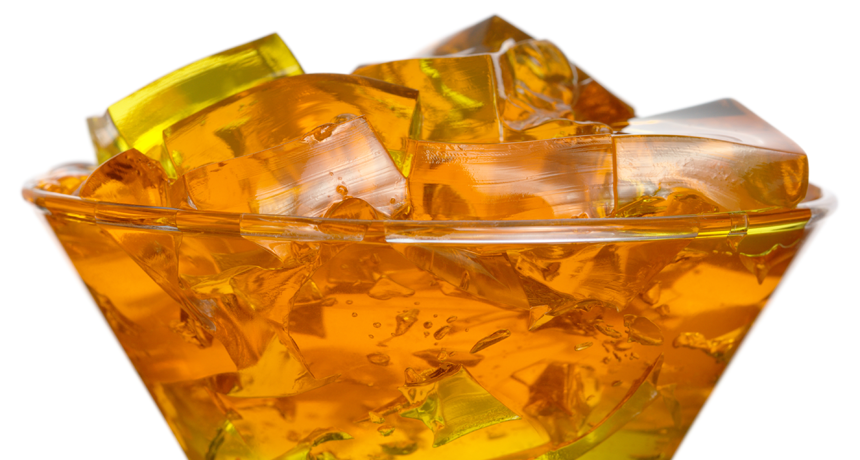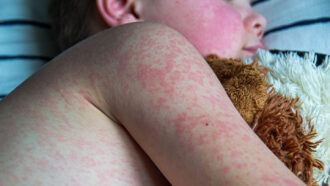Jiggly gelatin: Good workout snack for athletes?
This fun food may help repair wear and tear on the body — especially in girls, data show

Snacking on gelatin before exercise may help provide the body with nutritional building blocks useful for repairing injuries.
Kobyakov/iStockphoto
Downing a gelatin snack along with some O.J. before exercising might limit injury to bones and muscles, a new study shows. This means the jiggly snack might have health benefits.
Gelatin is an ingredient made from collagen, the most abundant protein in an animal’s body. (Most Americans know gelatin as the basis of Jell-O, a popular treat.) Collagen is part of our bones and ligaments. So Keith Baar wondered if eating gelatin might help those important tissues. As a physiologist at the University of California, Davis, Baar studies how the body works.
To test his idea, Baar and his colleagues had eight men jump rope for six minutes straight. Each man did this routine on three different days. An hour before each workout, the researchers gave the men a gelatin snack. But it differed slightly each time. On one day it had a lot of gelatin. Another time, it had just a little. On a third day, the snack contained no gelatin.
Neither the athletes nor the researchers knew on which day a man got a particular snack. Such tests are known as “double blind.” That’s because both the participants and scientists are “blind” to the treatments at the time. That keeps people’s expectations from affecting how they initially interpret the results.
On the day the men ate the most gelatin, their blood contained the highest levels of collagen’s building blocks, the researchers found. That suggested that eating gelatin might help the body make more collagen.
The team wanted to know whether these extra collagen building blocks might be good for ligaments, a tissue that connects bones. So the scientists collected another blood sample after each rope-skipping workout. Then they separated out the blood’s serum. This is a protein-rich liquid left behind when the blood cells are removed.
The researchers added this serum to cells from human ligaments that they were growing in a lab dish. The cells had formed a structure similar to a knee ligament. And serum from men who had eaten a gelatin-rich snack seemed to make that tissue stronger. For instance, the tissue didn’t tear as easily when tested in a machine that pulled on it from both ends.
Athletes who snack on gelatin may see similar benefits in their ligaments, Baar concludes. Their ligaments might not tear as easily. The gelatin snack may also help heal tears, he says.
His team described its findings late last year in the American Journal of Clinical Nutrition.
No guarantees in the real world
These results do suggest eating gelatin may help with tissue repair, agrees Rebekah Alcock. She is a dietician who did not take part in the new study. A graduate student at Australian Catholic University in Sydney, she studies supplements that might prevent injuries or help heal them. (She also works for the Australian Institute of Sport in Canberra.)
Still, she adds, this research is only in its early stages. It will take more work to prove that gelatin boosts tissue health. In fact, she says, a generally healthy diet may offer the same benefit.
But if gelatin does help strengthen and heal tissues, it could be especially important for athletic girls, Baar suspects.
Why? When girls hit puberty, their bodies begin making more estrogen. This is a hormone, a type of signaling molecule. Estrogen gets in the way of the chemical building blocks that help collagen stiffen and strengthen. Stiffer collagen keeps tendons and ligaments from moving as freely, which might prevent tears. If girls eat gelatin from a young age, Baar says, it may stiffen their collagen and help keep them injury-free as they get older.
Baar’s daughter, who is 9 years old, follows her dad’s advice. She eats a gelatin snack before playing soccer and basketball. Although Baar says Jell-O and other commercial brands should work, his daughter’s finger-food is homemade. Store-bought gelatin snacks have “too much sugar,” Baar says. That’s why he suggests buying gelatin and mixing it with fruit juice for flavor. He prefers one low in sugar and high in vitamin C (such as Ribena, a brand of black current juice).
Vitamin C actually plays an important role in collagen production. So to get the full benefits, Baar contends, athletes would need plenty of that vitamin in addition to the gelatin.
Eating gelatin rich in vitamin C could help mend a broken bone or torn ligament, Baar believes. “Bones are like cement,” he says. “If there’s a building being built out of cement, there are usually steel rods to give it strength. Collagen acts like the steel rods.” If you add gelatin to your diet, he explains, you’ll give your bones more collagen to build bone faster.
“It’s something to think about when we get hurt ― or really before it happens,” Baar says.







